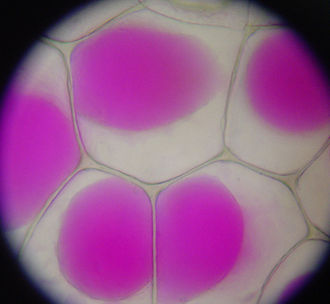Vacuole



Vacuole is a membrane-bound organelle found in the cells of most eukaryotic organisms. Vacuoles are fluid-filled compartments which are enclosed by a membrane known as the tonoplast. The primary function of vacuoles is to act as storage sites for various substances including water, nutrients, and waste products. In plant cells, vacuoles are particularly large and play a critical role in maintaining turgor pressure, which is essential for the structural integrity and growth of the plant.
Structure and Function[edit]
The structure of a vacuole can vary significantly between different types of cells and organisms. In plant cells, the vacuole can occupy up to 90% of the cell's volume and is crucial for storing water and maintaining turgor pressure. This pressure is vital for supporting the plant's structure and driving the expansion of cells during growth. In addition to storage, vacuoles in plants also play roles in cell signaling, detoxification, and the degradation of cellular components.
In animal cells, vacuoles are generally smaller and more numerous. They perform similar functions in terms of storage and waste removal but are also involved in processes such as endocytosis, where they help to ingest and break down external materials, and exocytosis, where they expel waste products out of the cell.
Yeast and other fungi also contain vacuoles that are essential for their growth and survival. In these organisms, vacuoles are involved in the storage of ions, amino acids, and other nutrients. They also play a role in the regulation of cytosolic pH and osmotic balance.
Types of Vacuoles[edit]
There are several types of vacuoles, including:
- Central vacuoles in plant cells, which are large and primarily responsible for storage and maintaining turgor pressure.
- Contractile vacuoles found in some protists, such as amoeba and paramecium, which help in osmoregulation by expelling excess water from the cell.
- Food vacuoles that are formed during phagocytosis in animal cells and protists, used for the digestion of ingested materials.
- Storage vacuoles that contain reserves of important nutrients such as proteins, lipids, and carbohydrates.
Biological Importance[edit]
Vacuoles play several vital roles in cellular function and organismal health. In plants, they are essential for growth, development, and the ability to withstand drought and other environmental stresses. In animals and other eukaryotes, vacuoles are involved in nutrient storage, waste management, and the protection against pathogens through the isolation and breakdown of harmful substances.
Research and Applications[edit]
Research into vacuoles has provided insights into how cells manage resources, respond to stress, and regulate their internal environments. Understanding the mechanisms of vacuole function has applications in agriculture, medicine, and biotechnology. For example, manipulating vacuole size and function in plants could lead to crops that are more resistant to drought and disease.

Ad. Transform your life with W8MD's Budget GLP-1 injections from $75


W8MD offers a medical weight loss program to lose weight in Philadelphia. Our physician-supervised medical weight loss provides:
- Weight loss injections in NYC (generic and brand names):
- Zepbound / Mounjaro, Wegovy / Ozempic, Saxenda
- Most insurances accepted or discounted self-pay rates. We will obtain insurance prior authorizations if needed.
- Generic GLP1 weight loss injections from $75 for the starting dose.
- Also offer prescription weight loss medications including Phentermine, Qsymia, Diethylpropion, Contrave etc.
NYC weight loss doctor appointmentsNYC weight loss doctor appointments
Start your NYC weight loss journey today at our NYC medical weight loss and Philadelphia medical weight loss clinics.
- Call 718-946-5500 to lose weight in NYC or for medical weight loss in Philadelphia 215-676-2334.
- Tags:NYC medical weight loss, Philadelphia lose weight Zepbound NYC, Budget GLP1 weight loss injections, Wegovy Philadelphia, Wegovy NYC, Philadelphia medical weight loss, Brookly weight loss and Wegovy NYC
|
WikiMD's Wellness Encyclopedia |
| Let Food Be Thy Medicine Medicine Thy Food - Hippocrates |
Medical Disclaimer: WikiMD is not a substitute for professional medical advice. The information on WikiMD is provided as an information resource only, may be incorrect, outdated or misleading, and is not to be used or relied on for any diagnostic or treatment purposes. Please consult your health care provider before making any healthcare decisions or for guidance about a specific medical condition. WikiMD expressly disclaims responsibility, and shall have no liability, for any damages, loss, injury, or liability whatsoever suffered as a result of your reliance on the information contained in this site. By visiting this site you agree to the foregoing terms and conditions, which may from time to time be changed or supplemented by WikiMD. If you do not agree to the foregoing terms and conditions, you should not enter or use this site. See full disclaimer.
Credits:Most images are courtesy of Wikimedia commons, and templates, categories Wikipedia, licensed under CC BY SA or similar.
Translate this page: - East Asian
中文,
日本,
한국어,
South Asian
हिन्दी,
தமிழ்,
తెలుగు,
Urdu,
ಕನ್ನಡ,
Southeast Asian
Indonesian,
Vietnamese,
Thai,
မြန်မာဘာသာ,
বাংলা
European
español,
Deutsch,
français,
Greek,
português do Brasil,
polski,
română,
русский,
Nederlands,
norsk,
svenska,
suomi,
Italian
Middle Eastern & African
عربى,
Turkish,
Persian,
Hebrew,
Afrikaans,
isiZulu,
Kiswahili,
Other
Bulgarian,
Hungarian,
Czech,
Swedish,
മലയാളം,
मराठी,
ਪੰਜਾਬੀ,
ગુજરાતી,
Portuguese,
Ukrainian